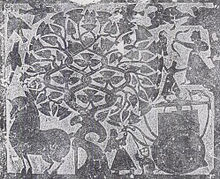

The Wu Family Shrines (Chinese: 武氏祠), of which the Wu Liang Shrine (武梁祠) is the best known, was the family shrine of the Wu clan of the Eastern Han dynasty. The shrines contain a vast amount of relief carvings.
Three walls of Wu Liang's shrine were still standing as late as the 11th century, which is the reason that the site of all the family shrines are often called after him. The shrine to Wu Liang (78-151 AD) was built in 151 AD in what is now Jiaxiang County of southwestern Shandong province.
In the 1930s, Wilma Fairbank visited the site and advanced the study of the tombs by treating the relief carvings as architectural wholes rather than pictorial art.
References
- ^ Wu, Hung (1989). The Wu Liang Shrine: The Ideology of Early Chinese Pictorial Art. Stanford: Stanford University Press. pp. xvi–xix. ISBN 9780804715294.
- "Rubbing of stone relief from the offering shrines of Wuliangci of the Han dynasty. Traditional grouping Wu Liang Group 3". Art Gallery of New South Wales. Retrieved 31 May 2017.
Further reading
- Berger, Patricia. “The ‘Battle at the Bridge’ at Wu Liang Tz’u: A Problem in Method.” Early China 2 (1976): 3–8. https://doi.org/10.1017/S036250280000465X.
- Chavannes, Édouard. |Mission archéologique dans la Chine septentrionale: Planches. Imprimerie nationale, 1915.
External links
- Barbieri, Anthony (2019). Virtual Tour of Wuzhai Shan Site, 2nd Century CE (v. 2.0). University of California, Santa Barbara.
This China-related article is a stub. You can help Misplaced Pages by expanding it. |